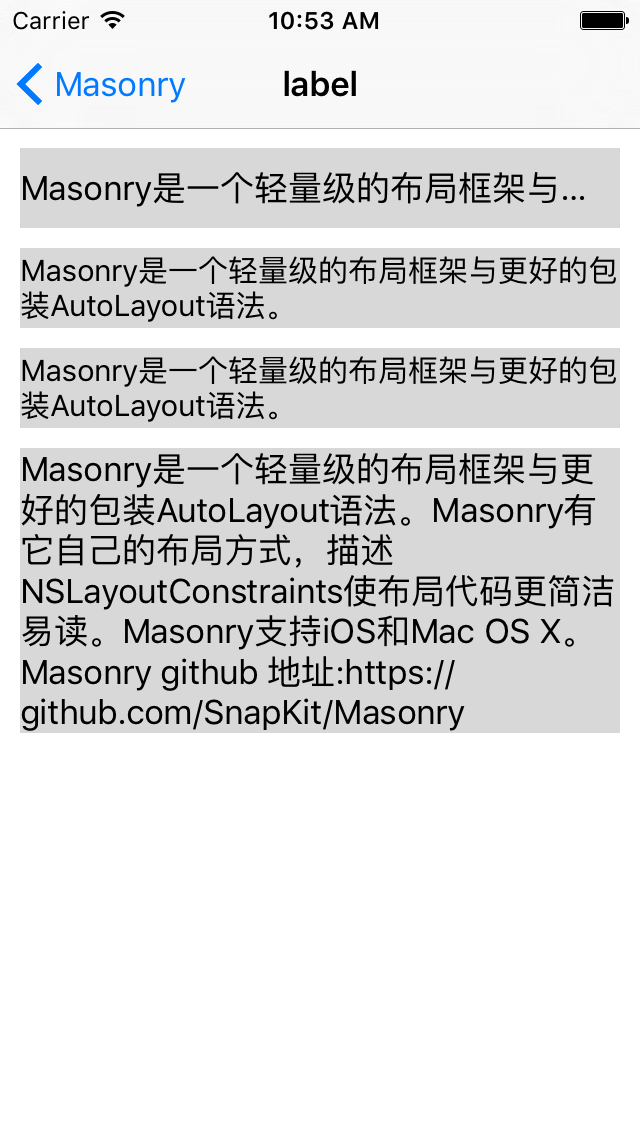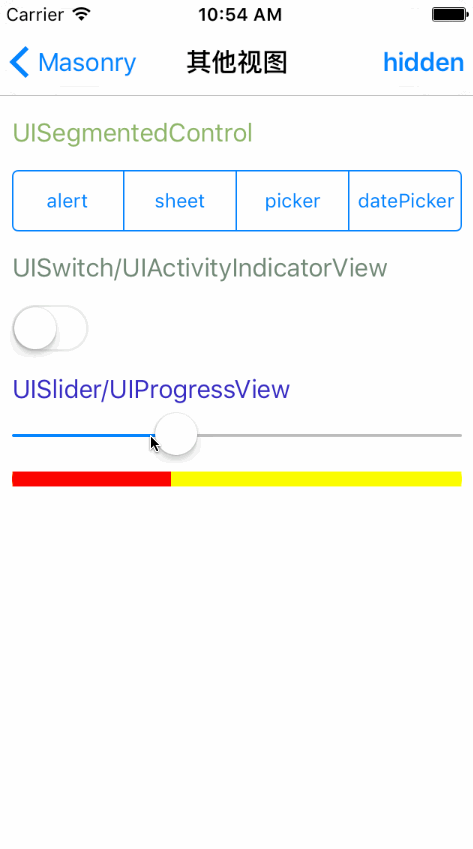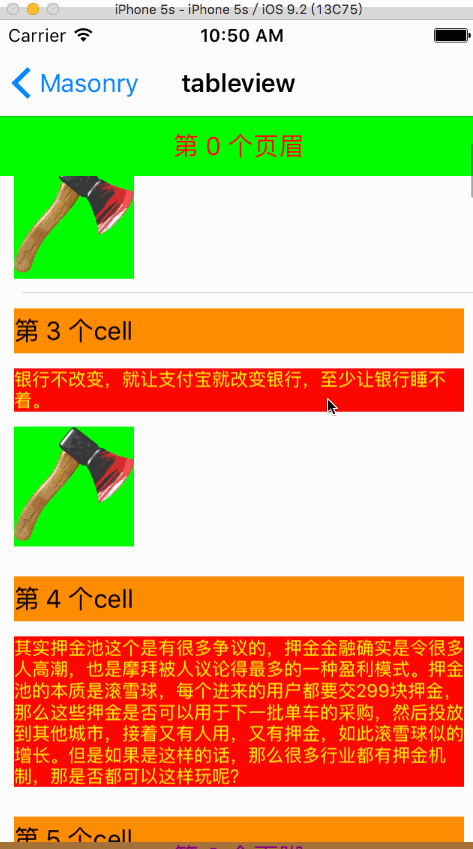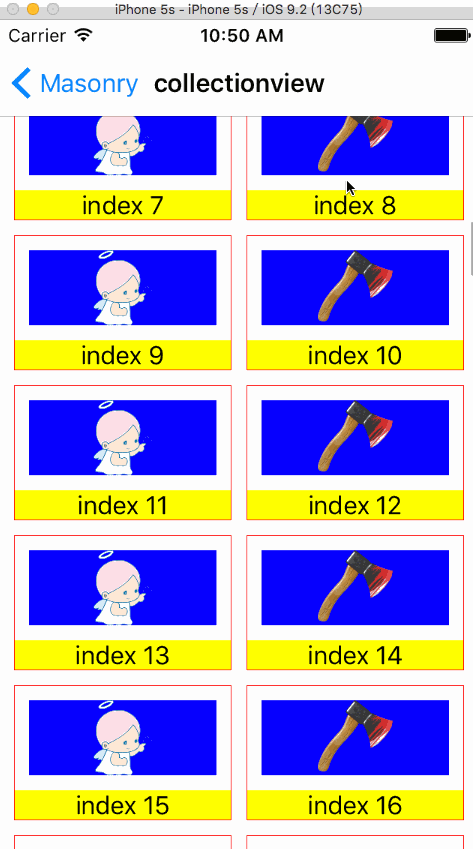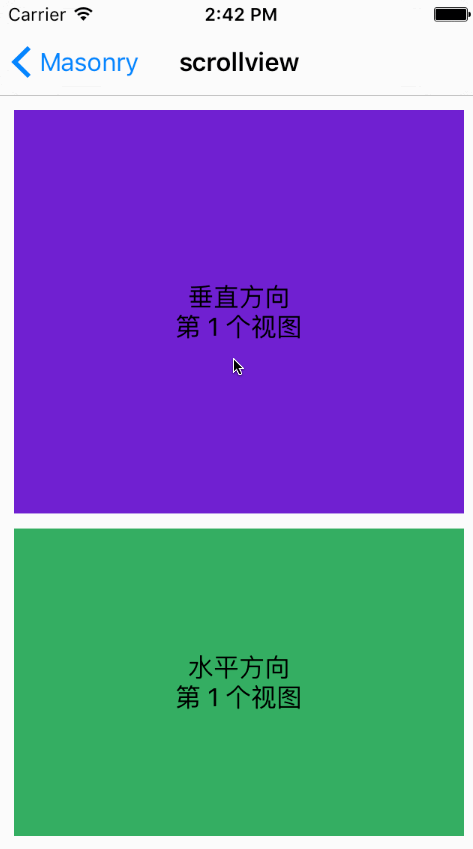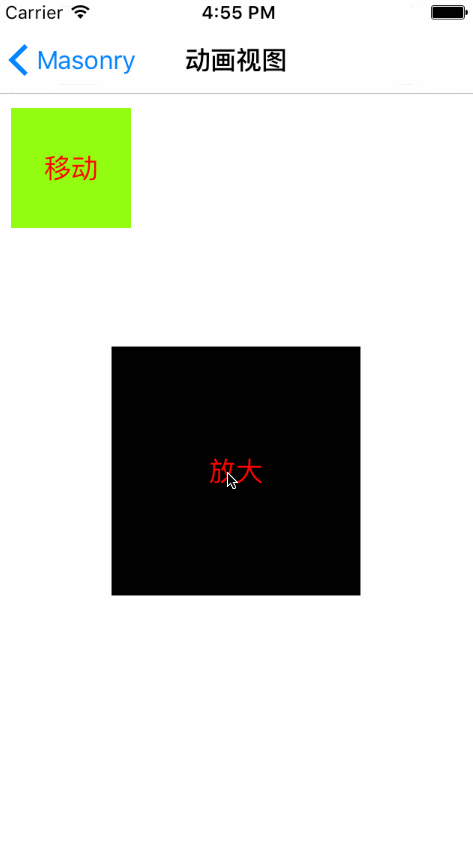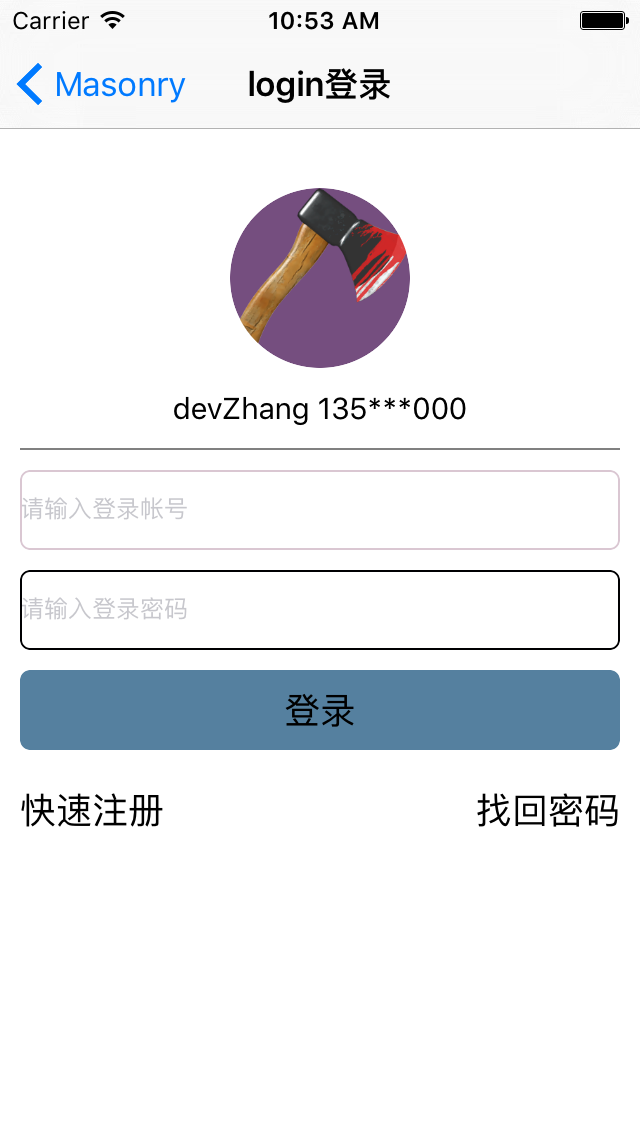使用masonry进行适配
效果图
- UILabel标签(含多行自适应)
- UI视图(其他UI)
- UITabelView列表视图
- UICollectionView瀑布视图
- UIScrollView滚动视图
- Animation动画效果
- 登录视图示例
#常用方法
- 1 添加约束 mas_makeConstraints
- 2 更新约束、也可以添加新约束 mas_updateConstraints
- 3 重置之前的约束 mas_remakeConstraints
#使用注意事项
- 1、使用autolayout之前,一定要将视图添加到父视图上,否则会报错。
- 2、使用autolayout时,不能同事对同一个视图使用mas_makeConstraints,否则会报错。
- 3、使用autolayout时,如果非要修改约束时,可使用mas_updateConstraints进行修改更新。
- 4、使用autolayout时,可使用mas_remakeConstraints清除之前的所有约束,仅保留最新的约束。
- 5、mas_equal支付的数据类型包括:NSNumber,CGPoint,CGSize,UIEdgeInsets。
- 6、equalTo与mas_equalTo的区别:equalTo比较的是view,而mas_equalTo比较的是值。
- 7、边界中顶部、左侧边界的数值为正整数;而底部、右侧边界的数值为负整数(原因在于计算的是绝对的数值,即计算的底部,或右侧边界的数值时,相对的视图底部高度,或右侧宽度,所以要负数)。
- 8、多个视图的父视图相同时,须先实例化多个视图,且多个视图都添加到视图后才进行约束设置。
- 9、更新约束后,需要刷新UI布局时,需要调用下面的方法
- (void)setNeedsLayout;
- (void)layoutIfNeeded;
- (void)setNeedsUpdateConstraints;- 情况1:实例化UI后,先通过mas_makeConstraints添加约束,然后再通过mas_updateConstraints修改更新某一个约束,然后再调用layoutIfNeeded
// 1 添加约束
[view mas_makeConstraints:^(MASConstraintMaker *make) {
make.center.equalTo(self.view);
make.size.mas_equalTo(CGSizeMake(80.0, 80.0));
}];
// 2 修改更新约束
[view mas_updateConstraints:^(MASConstraintMaker *make) {
make.top.mas_equalTo(originTop);
make.left.mas_equalTo(originLeft);
}];
// 3 调用更新
[self.view layoutIfNeeded];- 情况2:实例化UI后,先通过mas_makeConstraints添加约束,然后再通过mas_remakeConstraints重置所有约束,然后再调用layoutIfNeeded
// 1 添加约束
[view mas_makeConstraints:^(MASConstraintMaker *make) {
make.center.equalTo(self.view);
make.size.mas_equalTo(CGSizeMake(80.0, 80.0));
}];
// 2 重置所有约束
[view mas_remakeConstraints:^(MASConstraintMaker *make) {
make.top.mas_equalTo(originTop);
make.left.mas_equalTo(originLeft);
make.size.mas_equalTo(CGSizeMake(80.0, 80.0));
}];
// 3 调用更新
[self.view layoutIfNeeded];- 情况3:实例化UI后,暂不添加约束,后通过updateViewConstraints方法里添加约束mas_updateConstraints,然后再调用setNeedsUpdateConstraints、layoutIfNeeded
// 1
- (void)updateViewConstraints
{
[view mas_updateConstraints:^(MASConstraintMaker *make) {
make.center.equalTo(self.view);
make.size.mas_equalTo(self.sizeScale);
}];
[super updateViewConstraints];
}
// 2 调用更新
[self.view setNeedsUpdateConstraints];
[self.view layoutIfNeeded];#使用设置
-
1、居中设置
-
垂直居中:make.centerY.mas_equalTo(self.window.mas_centerY)
-
水平居中:make.centerX.mas_equalTo(self.window.mas_centerX)
-
全屏居中:make.center.equalTo(self.window)
-
2、边界设置
-
上边界:make.top.equalTo(self.window).with.offset(15.0)
-
左边界:make.left.equalTo(self.window).with.offset(15.0)
-
下边界:make.bottom.equalTo(self.window).with.offset(-15.0)
-
右边界:make.right.equalTo(self.window).with.offset(-15.0)
-
或:
-
上边界:make.top.mas_equalTo(15.0)
-
左边界:make.left.mas_equalTo(15.0)
-
下边界:make.bottom.mas_equalTo(-15.0)
-
右边界:make.right.mas_equalTo(-15.0)
-
或:
-
上边界、左边界:make.top.left.mas_equalTo(15.0)
-
下边界、右边界:make.bottom.right.mas_equalTo(-15.0)
-
或:
-
make.top.left.bottom.and.right.equalTo(self.window).with.insets(UIEdgeInsetsMake(15.0,15.0,15.0,15.0))
-
或:
-
make.edges.equalTo(self.window).with.insets(UIEdgeInsetsMake(15.0,15.0,15.0,15.0))
-
与另一个视图的边界间距设置
-
与另一个视图右部边界间距:
-
make.right.mas_equalTo(currentView.mas_left).offset(10.0);
-
与另一个视图底部边界间距:
-
make.top.mas_equalTo(currentView.mas_bottom).offset(10.0);
-
3、equalTo与mas_equalTo有什么区别?
-
equalTo比较的是view
-
mas_equalTo比较的是数值
-
4、and和with?
-
什么事情都没做,只是增加代码可读性。
-
5、倍数设置
-
设置宽度为self.view的一半,multipliedBy是倍数的意思,也就是,使宽度等于self.view宽度的0.5倍
-
make.width.equalTo(self.view.mas_width).multipliedBy(0.5);
-
设置高度为self.view高度的一半
-
make.height.equalTo(self.view.mas_height).multipliedBy(0.5);
-
6、大小设置
-
(1)宽:
-
make.width.equalTo(self.view.mas_width).multipliedBy(0.5);
-
或:make.width. mas_equalTo(320.0).multipliedBy(0.5);
-
或:make.width. mas_equalTo(160.0);
-
(2)高:make.height.equalTo(self.view.mas_height).multipliedBy(0.5);
-
或:make.height. mas_equalTo(320.0).multipliedBy(0.5);
-
或:make.height. mas_equalTo(160.0);
-
(3)size:make.size. mas_equalTo(CGSizeMake(300.0,50.0));
-
或:make.size.equalTo(view);
-
或:make.size.mas_equalTo(CGSizeMake(150.0,50.0)).multipliedBy(0.5);
-
或:make.edges.equalTo(self.view);
#疑问:
- 1、UILable如何设置多行显示?
self.detailLabel = [UILabel new];
self.detailLabel.font = [UIFont systemFontOfSize:15];
self.detailLabel.backgroundColor = [UIColor whiteColor];
[self addSubview:self.detailLabel];
// 多行自适应显示
// 情况1 多行自适应显示,无需设置高度约束
self.detailLabel.numberOfLines = 0;
self.detailLabel.preferredMaxLayoutWidth = ([UIScreen mainScreen].bounds.size.width - 2 * 10.0); // 要是设置多行Label的话,必须设置此属性
[self.detailLabel setContentHuggingPriority:UILayoutPriorityRequired forAxis:UILayoutConstraintAxisVertical];
[self.detailLabel mas_makeConstraints:^(MASConstraintMaker *make) {
make.top.mas_equalTo(self.footTitleBackView.mas_bottom).offset(5);
make.left.and.right.mas_equalTo(0);
make.bottom.mas_equalTo(self.mas_bottom);
// 无需设置高度约束
}];
// 情况2 多行自适应显示,计算高度,设置高度约束(不足:可能会造成文本显示不全)
self.detailLabel.numberOfLines = 0;
CGFloat height = [self.detailLabel.text boundingRectWithSize:CGSizeMake(([UIScreen mainScreen].bounds.size.width - 2 * 10.0), MAXFLOAT) options:NSStringDrawingUsesLineFragmentOrigin attributes:@{NSFontAttributeName:self.detailLabel.font} context:nil].size.height;
[self.detailLabel mas_makeConstraints:^(MASConstraintMaker *make) {
make.top.mas_equalTo(self.footTitleBackView.mas_bottom).offset(5);
make.left.and.right.mas_equalTo(0);
make.bottom.mas_equalTo(self.mas_bottom);
// 设置高度约束
make.height.mas_equalTo(height);
}]; - 2、UITextView如何设置自适应多行显示? UITextView实始化时,设置的约束只能显示一行,随着输入内容的不断增多,可以在代理方法中实现高度自适应,即重新更新高度约束。
// 初始化约束
[textview mas_makeConstraints:^(MASConstraintMaker *make) {
make.top.mas_equalTo(currentView.bottom).offset(10);
make.left.equalTo(currentView);
make.right.mas_equalTo(-10);
make.height.mas_equalTo(40);
}];
// 代理方法中更新高度约束
- (BOOL)textView:(UITextView *)textView shouldChangeTextInRange:(NSRange)range replacementText:(NSString *)text
{
if (1001 == textView.tag)
{
NSString *string = [textView.text stringByReplacingCharactersInRange:range withString:text];
NSLog(@"string = %@", string);
CGSize size = [string boundingRectWithSize:CGSizeMake((self.view.frame.size.width - 10.0 * 2), MAXFLOAT) options:NSStringDrawingUsesLineFragmentOrigin attributes:@{NSFontAttributeName:[UIFont systemFontOfSize:12.0]} context:nil].size;
CGFloat height = size.height;
NSLog(@"height = %@", @(height));
// 根据实际高度,更新约束
if (height > textView.frame.size.height)
{
[textView mas_updateConstraints:^(MASConstraintMaker *make) {
make.height.mas_equalTo(height);
}];
}
}
return YES;
}- 3、UISCrollView如何设置contentSize?
- 通过过渡视图设置。
- (1)containerView为crollView的过渡子视图(垂直设置原理说明);
- (2)containerView相对于crollView的约束为make.top.left.bottom.and.right.equalTo(crollView).with.insets(UIEdgeInsetsZero); make.width.equalTo(crollView);
- (3)containerView的多个子视图label,且containerView的高度约束最终为最后一个子视图label:make.bottom.equalTo(label.mas_bottom);
- (4)containerView的高度约束,即为crollView的垂直方向的高度约束。
// 垂直方向
UIScrollView *verticalScrollView = [[UIScrollView alloc] init];
......
// 设置scrollView的子视图,即过渡视图contentSize,并设置其约束
UIView *verticalContainerView = [[UIView alloc] init];
[verticalScrollView addSubview:verticalContainerView];
[verticalContainerView mas_makeConstraints:^(MASConstraintMaker *make) {
make.top.left.bottom.and.right.equalTo(verticalScrollView).with.insets(UIEdgeInsetsZero);
make.width.equalTo(verticalScrollView);
}];
// 过渡视图添加子视图
UIView *lastView = nil;
for (NSInteger index = 0; index < 10; index++)
{
UILabel *label = [[UILabel alloc] init];
......
// 添加到父视图,并设置过渡视图中子视图的约束
[verticalContainerView addSubview:label];
[label mas_makeConstraints:^(MASConstraintMaker *make) {
make.left.and.right.equalTo(verticalContainerView);
make.height.mas_equalTo(verticalScrollView.mas_height);
if (lastView)
{
make.top.mas_equalTo(lastView.mas_bottom);
}
else
{
make.top.mas_equalTo(0);
}
}];
lastView = label;
}
// 设置过渡视图的底边距(此设置将影响到scrollView的contentSize)
[verticalContainerView mas_makeConstraints:^(MASConstraintMaker *make) {
make.bottom.equalTo(lastView.mas_bottom);
}];
// 水平方向
UIScrollView *horizontalScrollView = [[UIScrollView alloc] init];
......
// 设置scrollView的子视图,即过渡视图contentSize,并设置其约束
UIView *horizontalContainerView = [[UIView alloc] init];
[horizontalScrollView addSubview:horizontalContainerView];
[horizontalContainerView mas_makeConstraints:^(MASConstraintMaker *make) {
make.edges.equalTo(horizontalScrollView);
make.height.equalTo(horizontalScrollView);
}];
// 过渡视图添加子视图
UIView *previousView = nil;
for (int i = 0; i < 10; i++)
{
UILabel *label = [[UILabel alloc] init];
......
// 添加到父视图,并设置过渡视图中子视图的约束
[horizontalContainerView addSubview:label];
[label mas_makeConstraints:^(MASConstraintMaker *make) {
make.top.and.bottom.equalTo(horizontalContainerView);
make.width.equalTo(horizontalScrollView);
if (previousView)
{
make.left.mas_equalTo(previousView.mas_right);
}
else
{
make.left.mas_equalTo(0);
}
}];
previousView = label;
}
// 设置过渡视图的右距(此设置将影响到scrollView的contentSize)
[horizontalContainerView mas_makeConstraints:^(MASConstraintMaker *make) {
make.right.mas_equalTo(previousView.mas_right);
}];- 4、UITableView如何设置UITableViewCell的高度?
- 在自自定义,或系统的UITableViewCell中,根据数据model显示,或隐藏UI子视图,以及UILabel的自适应显示(需要先设置多行自适应显示的属性)。同时,在代理方法中设置计算返回的高度。
// UILabel多行自适应显示属性
self.detailLabel.numberOfLines = 0;
self.detailLabel.preferredMaxLayoutWidth = ([UIScreen mainScreen].bounds.size.width - 10.0 * 2);
[self.detailLabel setContentHuggingPriority:UILayoutPriorityRequired forAxis:UILayoutConstraintAxisVertical];
// UI子视图显示,或隐藏约束。如:
NSString *name = model.imageName;
if (name && 0 != name.length)
{
UIImage *image = [UIImage imageNamed:name];
self.iconImageView.image = image;
}
[self.iconImageView mas_updateConstraints:^(MASConstraintMaker *make) {
make.top.mas_equalTo(self.detailLabel.mas_bottom).offset(originXY);
make.size.mas_equalTo((name && 0 != name.length) ? CGSizeMake(sizeImage, sizeImage) : CGSizeZero);
}];
[self layoutIfNeeded];
// 计算高度
+ (CGFloat)heightTableCellWithModel:(Model *)model
{
// 初始化高度
CGFloat height = ....;
// 计算高度
NSString *text = model.content;
CGFloat heightText = [text boundingRectWithSize:CGSizeMake(([UIScreen mainScreen].bounds.size.width - 2 * 10.0), MAXFLOAT) options:NSStringDrawingUsesLineFragmentOrigin attributes:@{NSFontAttributeName:[UIFont systemFontOfSize:12.0]} context:nil].size.height;
height += heightText;
NSLog(@"heightTableCell = %f, heightText = %f", height, heightText);
return height;
}
// 代理方法中设置高度
- (CGFloat)tableView:(UITableView *)tableView heightForRowAtIndexPath:(NSIndexPath *)indexPath
{
Model *model = self.array[indexPath.row];
CGFloat height = [UITableViewCell heightTableCellWithModel:model];
return height;
}- 5、如何处理动画效果?
- 实现动画效果,即修改更新UI的约束即可,可以使用mas_updateConstraints更新某个约束,也可以使用mas_remakeConstraints清除之前的约束,重新设置所有约束。但不管何种方式,都需要UI所有的父视图调用方法"- (void)layoutIfNeeded;"。
// 初始约束
[aniView mas_makeConstraints:^(MASConstraintMaker *make) {
make.top.equalTo(self.view).offset(10);
make.left.equalTo(self.view).offset(10);
make.right.equalTo(self.view).offset(-10);
make.height.equalTo(@(80));
}];
// 更新某个约束
[aniView mas_updateConstraints:^(MASConstraintMaker *make) {
make.top.equalTo(self.view).offset(30);
}];
// 或更新所有约束
[aniView mas_remakeConstraints:^(MASConstraintMaker *make) {
make.top.equalTo(self.view).offset(30);
make.left.equalTo(self.view).offset(10);
make.right.equalTo(self.view).offset(-10);
make.height.equalTo(@(80));
}];
// 动画
[UIView animateWithDuration:3 animations:^{
[self.view layoutIfNeeded];
}];-
6、如何动态修改约束
-
使用mas_updateConstraints修改更新某一个约束
-
使用mas_remakeConstraints,清除之前的所有约束,重新添加约束
-
7、如何获取约束里设置的值,或是获取约束对象的frame
-
8、约束中edge、size设置的区别
-
设置某个子视图的大小与其父视图相同大小时,如frame中设置:label.frame = self.view.bounds;,可以使用size约束,也可以使用edges约束。 *(1)size约束(可能会出现约束异常):make.size.equalTo(self.view); *(2)edges约束(建议使用此方法):make.edges.equalTo(self.view);
